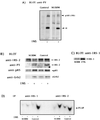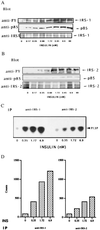Insulin receptor substrate (IRS) 1 is reduced and IRS-2 is the main docking protein for phosphatidylinositol 3-kinase in adipocytes from subjects with non-insulin-dependent diabetes mellitus
- PMID: 9108124
- PMCID: PMC20591
- DOI: 10.1073/pnas.94.8.4171
Insulin receptor substrate (IRS) 1 is reduced and IRS-2 is the main docking protein for phosphatidylinositol 3-kinase in adipocytes from subjects with non-insulin-dependent diabetes mellitus
Abstract
The large docking protein IRS-1 is a major substrate for the insulin receptor and other tyrosine kinases. It plays a key role in eliciting many of insulin's actions, including binding and activation of phosphatidylinositol (PI) 3-kinase and the subsequent increase in glucose transport. Gene disruption of IRS-1 in mice is associated with an impaired insulin-stimulated glucose disposal in vivo and glucose transport in vitro, but the survival of the animals and residual insulin sensitivity is dependent on the presence of the alternative docking protein IRS-2. We examined the expression and function of IRS-1 and IRS-2 in adipocytes from healthy and diabetic individuals. Cells from subjects with non-insulin-dependent diabetes mellitus (NIDDM), but not with insulin-dependent diabetes mellitus, had an impaired insulin effect and a marked reduction (70 +/- 6%) in the expression of IRS-1 protein, whereas IRS-2 was unchanged. In normal cells, IRS-1 was the main docking protein for the binding and activation of insulin-stimulated PI 3-kinase; IRS-2 was also functional but required a higher insulin concentration for a similar binding and activation of PI 3-kinase. In contrast in NIDDM cells with a low IRS-1 content, IRS-2 became the main docking protein. These findings may provide important reasons for the insulin resistance in NIDDM.
Figures




References
-
- Eriksson J, Franssila-Kallunki A, Ekstrand A, Saloranta C, Widen E, Schalin C, Groop L. N Engl J Med. 1989;321:337–343. - PubMed
-
- Martin B C, Warram J H, Krolewski A S, Bergman R N, Soeldner J S, Kahn C R. Lancet. 1992;340:925–929. - PubMed
-
- White M F, Kahn C R. J Biol Chem. 1994;269:1–4. - PubMed
-
- Kahn C R. Diabetes. 1994;43:1066–1084. - PubMed
-
- Cushman S W, Wardzala L J. J Biol Chem. 1980;255:4758–4762. - PubMed
Publication types
MeSH terms
Substances
LinkOut - more resources
Full Text Sources
Other Literature Sources
Medical
Research Materials
Miscellaneous

